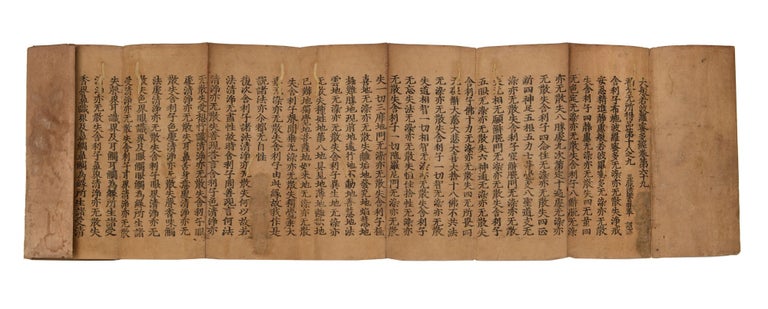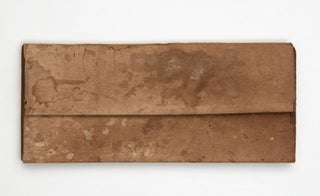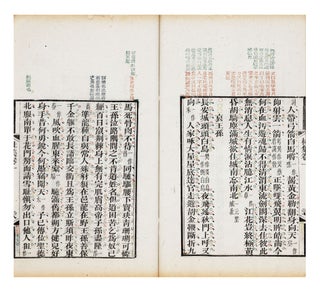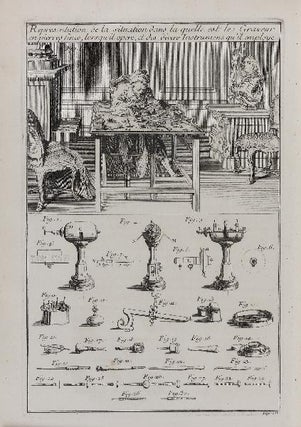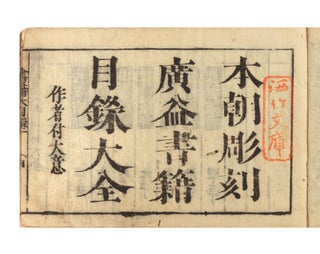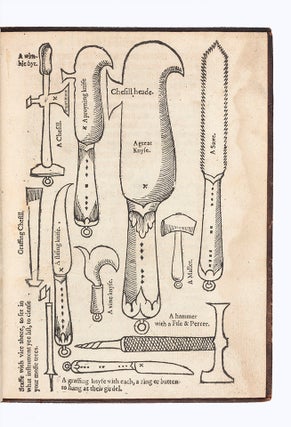Chikan Ban, Printed 1363
Orihon (accordion format) woodblock-printed book of Vol. 69 of the Sutra of Perfection of Wisdom or Mahaprajnaparamitasutra, Japanese title reading: “Daihannya haramitta kyo kan dai rokuju kyu.”
Six columns per page, 17 characters per column, text-block height 205 mm. 15 joined sheets. 81 pages. Tall narrow 8vo (275 x 115 mm.), orig. semi-stiff wrappers to form a “wallet binding.” [Kanto region?]: printed at end, “Ke’en bikuni Chikan, January 1363.”
An extremely rare dated sutra, printed by the monk Chikan in January 1363, apparently in the Kanto region. It has been printed on fine thick paper (gampi or mulberry fibers), with bold, thick strokes, using black sumi ink.
According to the blog of a local printing historian in Yamanashi Prefecture, who is a member of the Hobundo Company (the author does not give his name), the Chikan edition of the Sutra of Perfection of Wisdom was carved in the Kanto region around Tokyo between 1356 and 1410. Chikan was a Buddhist priest with the rank of Biku. Chikan’s most important sponsors were members of the ruling Ashikaga clan, including Takauji Ashikaga (1305-58), the first shogun of the Ashikaga shogunate, and his two sons. The author of the above-mentioned blog speculates that, as the Ashikagas resided in the Kanto region, the Chikan edition was printed nearby.
The Mahaprajnaparamitasutra is a massive compilation of scriptural literature said to have been preached by the Buddha in four different places to 16 discrete assemblies. It includes seminal works such as the Prajnaparamita in One Hundred Thousand Lines and the Diamond Sutra. “This recension of the scripture is only extant in a Chinese translation made in six hundred rolls by Xuanzang and his translation team between the years 660 and 663. Xuanzang’s recension is by far the largest of all the prajnaparamita scriptures in the Chinese Buddhist canon…The Mahaprajnaparamitasutra also often holds pride of place as the first sutra found in many traditional East Asian Buddhist scriptural canons.”–Buswell & Lopez, eds., The Princeton Dictionary of Buddhism, p. 505.
The translator of the Perfection of Wisdom, Xuanzang (596?-664), was a Chinese Buddhist pilgrim, monk, scholar, and patriarch of the Chinese Yogacara tradition. Along with Kumarajiva (344-413), Xuanzang was one of the two most influential and prolific translators of Indian Buddhist texts into Chinese. In 627, he embarked on an epic journey to India, where he studied Sanskrit, and returned to China in 645 with over 600 Sanskrit manuscripts in his luggage, along with images, relics, and other artifacts. Settling in the Tang capital of Chang’an, he established a translation bureau, where he oversaw a team of monks who transcribed the texts and, in the process, made translations, polished the renderings, clarified texts, and certified both their meaning and syntax.
A very good copy, preserved in a modern chitsu. There is some worming, touching characters (which remain perfectly legible). The worming to the first 15 pages has been mended with paper selected to match the color of the book’s paper. The author of the above-mentioned blog states that in the blank areas of each sutra, the names of the donors have been supplied in manuscript. In our copy, the names have been erased in eight of the nine areas intended for donors’ names (we had another copy of a Chikan ban with all the names erased). The surviving donor name is “Iwatono san. Entsuji.” Entsuji was a temple on Mount Iwatono in Yamanashi Prefecture, founded in 806. On the final page is a manuscript inscription with the name “Kanjinso,” a travelling priest, dated June 1399.
❧ For the link to the blog, please contact us. With many thanks to Prof. Peter Kornicki of Cambridge University for pointing us in the right directions.
Price: $7,500.00
Item ID: 8676

